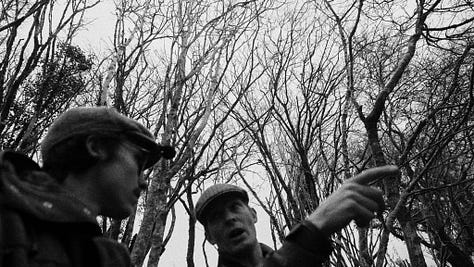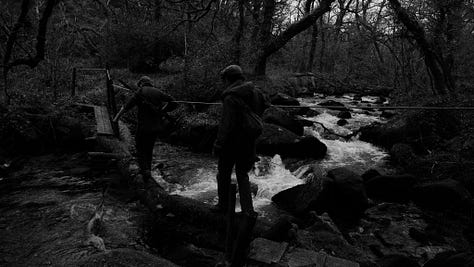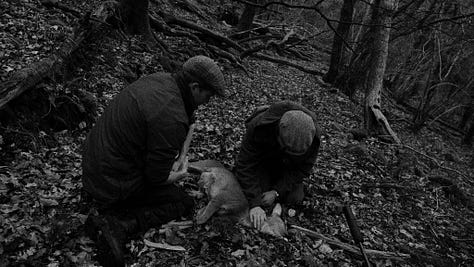Full YouTube Video of the Hunt
As I lace up my boots, preparing to step onto Bodmin Moor, I think about how this landscape was once covered in Atlantic rainforest. Before agriculture reshaped the land, the west of Britain was home to temperate rainforests teeming with wildlife, including species we no longer see—like the tree frog. It’s hard to imagine now, but this was once a thriving, biodiverse ecosystem.
Cabilla, where I’ll be hunting, is a rainforest regeneration project led by Merlin, the landowner and MD of the Thousand Year Trust. He hunts deer on his land—not for sport, but for conservation. In the UK, we’ve wiped out the predators that once managed deer populations. Now, their numbers are out of control, stripping forests bare and preventing regeneration. The balance has already been broken, and as I’ve come to learn, when you tamper with nature once, you have to tamper again.
For most of my life, hunting was an alien concept. I never imagined I’d find myself holding a rifle. Guns felt unnatural to me, foreign. And yet, here I am, about to step into a practice as old as humanity itself. It’s illegal to hunt with a bow and arrow in the UK, so for now, a gun is my tool. But one day, I’d love to learn the ways of the bow.
Hunting, in modern Western culture, is often seen as savage. But as I deepen my connection to ancestral practices and explore rewilding, I realise that wild food—especially wild meat—is an integral part of this journey. If I’m going to continue eating meat, I feel compelled to meet the grief that comes with it.
I’ve taken life before—fish, crabs, small creatures—but never a deer. If we take one today, it will be the largest life I’ve taken, and I don’t know how that will feel. But I do know this: there is responsibility in this act, and I must be ready to hold it.
The Necessity of Deer Management
Some argue that we should leave nature alone. But the reality is, we already stepped in and disrupted the natural order. We eradicated the apex predators—lynx, wolves, bears—and now we must take up that role. Doing nothing isn’t neutrality—it’s negligence. When deer overpopulate, the land suffers. Young oak saplings are devoured before they can grow, leading to ecosystem collapse. Degraded soil, fewer insects, poorer crops—this affects everyone.
This isn’t a debate about whether meat-eating is good or bad. It’s about balance, about listening to the land, about understanding what is in abundance. When we talk about sustainability, we often look for one-size-fits-all solutions. But nature doesn’t work in absolutes. The answer isn’t should we eat meat—it’s what is a diet that best reflects the health of the ecosystem I live in?
A Journey Into the Hunt
Merlin takes me under his wing, walking me through the rifle, safety mechanisms, and the ethics of taking a shot. We move quietly through the land, searching. My heart pounds—anticipation, nerves, the weight of what I might do tonight.
As darkness falls, our chances increase. And then, suddenly—a deer. A roe doe. Merlin takes the shot, a clean kill. We approach, and the gravity of it hits me. I place my hand on her still-warm body, feeling gratitude, grief, reverence. This is the moment of initiation, of stepping into something ancient.
The next steps unfold in a blur—field dressing, carrying her back. The weight of her on my shoulders is more than physical. This deer will sustain me for weeks, especially as I prepare for the Wild Biome Project in May—a month of eating only wild food to study its effects on gut health. Her life will become part of mine.
The Ethics of Death
For many, hunting seems barbaric. But I’ve come to believe that factory farming and veganism actually share a common thread—an attempt to hide from death. Industrial agriculture, with its sterile supermarkets and packaged meats, keeps the process out of sight. Similarly, some vegans seek a world free from suffering. But there is no diet without death. Even plant agriculture requires mass clearing of land, displacing, fossil fuels and killing wildlife. Incomparable to industrial animal farming, but not devoid of suffering.
The truth is, death is woven into life. To exile the dark, the winter, the wild, is to create imbalance. Our ancestors understood this. They honoured the animals they took, they acknowledged the grief, and they moved forward in reciprocity with the land. We have lost that connection.
Hunters—real hunters, not sport hunters—often have a deeper understanding of ecology than most. They track populations, know migration patterns, understand which animals should be taken to maintain balance. This is not mindless killing. It is stewardship.
The Return to Food Sovereignty
For most of human history, our diets were dictated by the land. In spring, we may have eaten mostly plants. In the dead of winter, we relied on game. Our ancestors ate in cycles, not absolutes. But today, food has been commodified, disconnected from place. We eat tomatoes in December, blueberries from halfway across the world, meat from tortured animals. We have lost the knowledge of what the land is offering.
Reclaiming food sovereignty means listening. Learning what is abundant. Understanding that sustainability isn’t about rigid rules, but about working within the rhythms of nature.
And so, I step forward into this journey—not as a solution to all the world’s problems, but as an attempt to align my life with the land beneath my feet. This is what trying looks like for me.
I don’t know what hunting will mean for me long-term. I only know that today, it feels like an initiation. A return to something lost. A step toward food sovereignty, reciprocity, and deeper understanding.
Deep gratitude to deer, to the land, to the Thousand Year Trust and to Merlin for guiding me through my first deer stalk.







